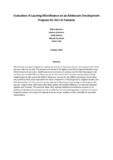| dc.description.abstract | The paper evaluates a program targeted towards adolescent women in Tanzania and aims to empower them both economically and socially. The program was found to be highly successful in Uganda in terms of economic, health and social outcomes. In contrast, the paper found that the program did not have any notable effect on the same set of outcomes in the Tanzanian setting, despite being implemented by the same NGO (BRAC). Moreover, the paper tested for the differential impact of providing microcredit services (over and above the main components of the program) to targeted women and found that addition of microcredit improves take-up of the program and savings of participants. Furthermore, the paper explored programmatic information that helps explain the marked difference in outcomes between Uganda and Tanzania. The research showed that layering additional microfinance services to an adolescent development program can be an effective tool of attaining greater inclusion of youth in financial services, and brings out important issues around replication and scalability of successful interventions. | en_US |

